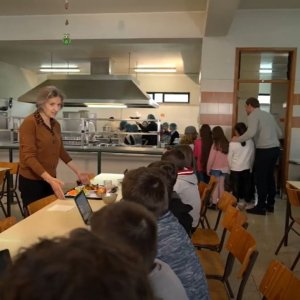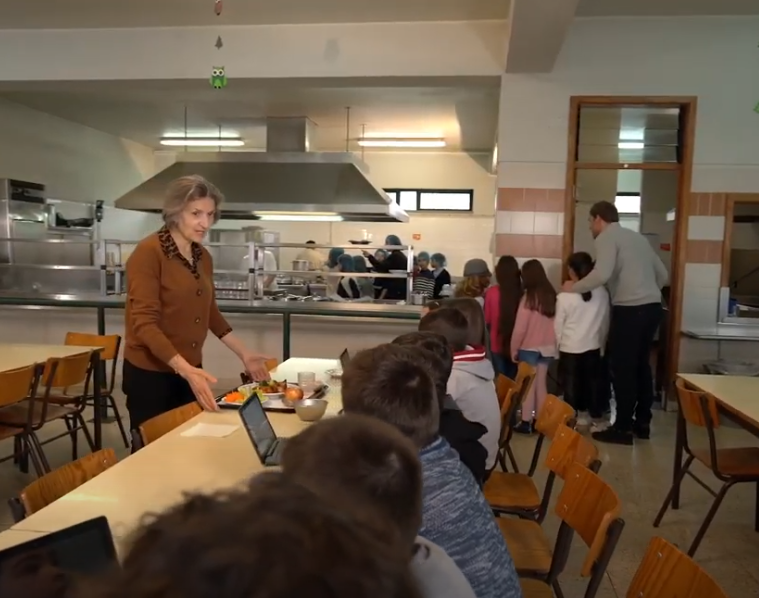
Little inspectors in the school cafeteria
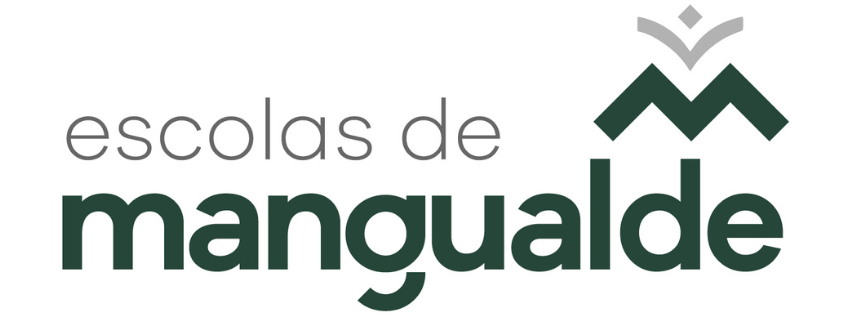
Activity description
In this activity, students become familiar with some essential safety and hygiene conditions in meal preparation, particularly in the school cafeteria, through a checklist created in a digital form. Students explore issues related to healthy and balanced nutrition by creating a “Healthy Plate” using the ingredients served in the cafeteria meal, measuring the appropriate quantities according to the energy needs of 1st cycle elementary school students, and recording and calculating these on a spreadsheet.
Issues related to the responsible use of water, aiming at the sustainability of the planet, are discussed through photographic documentation of tasks involving water consumption during meal preparation in the cafeteria.
At the end of the activity, the working groups present and share the recorded data and discuss their observations.
1 digital scale
4 tablets with Google Keep
2 computers
Google Keep installed on the tablets for photographic recording of tasks involving water consumption in the school cafeteria;
Spreadsheet for calculating the energy value of the meal on the cafeteria menu, available on each of the computers;
Digital form with a checklist of hygiene and safety conditions (opened on 2 tablets; if there is no internet access in the cafeteria, the form should be submitted in the classroom);
Request for collaboration from the school cafeteria team to schedule access for the classes to the meal preparation facilities, as well as to separate the lunch ingredients into plates or containers (for example, rice, steak, corn, which will constitute one plate per child).
Student profiles
Essential learnings
Please download the following files:
Activity guides
Introduction to the Activity
Students are asked about the meals they had, for example, on the previous day:
What did you have for breakfast yesterday? And lunch? And...? Is the amount of food we eat the same across different daily meals? Why? Typically, who eats more food between you and your father/mother/sibling during different meals? Why?
Development of the Activity
The concept of energy value appropriate for an age group is addressed. Reference values related to energy and nutritional needs for 1st cycle primary school children are discussed with the students. (Lima, 2018, pp. 9-10):
|
|
|||||||
|
Age group |
Energy Value for Lunch |
Macronutrients Energy value kcal (quantity g) Carbohydrates |
|||||
|
Lipids |
Proteins |
||||||
|
|
|
55 % |
75 % |
15 % |
30 % |
10 % |
15 % |
|
3 – 6 years |
420 kcal |
231 kcal (58 g) |
315 kcal (79 g) |
63 kcal (7 g) |
126 kcal (14 g) |
42 kcal (11 g) |
63 kcal (16 g) |
|
6 – 10 years (1.º CEB) |
492 kcal |
271 kcal (68 g) |
369 kcal (92 g) |
74 kcal (8 g) |
148 kcal (16 g) |
49 kcal (12 g) |
74 kcal (18 g) |
Reference values for energy and nutritional needs for 1st Cycle Primary School children
The discussion should not focus on the units of measurement (kilocalories and grams), but rather on the concept of reference values in the diet of children in the 1st Cycle of basic education. For preschool children, for example, these reference values are typically lower.
What has been discussed is then related to the "Healthy Eating Plate," and its different components are discussed with the students.

Group Distribution and Tasks
Students are divided into 6 groups, and their tasks are clearly defined:
-
Groups A1 and A2: Determine the daily menu's per capita serving (student guide - point 1).
-
Groups B1 and B2: Verify hygiene and safety conditions (student guide - point 2).
-
Groups C1 and C2: Identify tasks involving water usage in the cafeteria kitchen.
Each pair of groups will be accompanied by an adult during their visit to the school cafeteria.
Groups A1 and A2 Specifics
The groups responsible for determining the per capita serving of the day's menu will remain in the dining area. They will have access to a hybrid computer with a spreadsheet. This spreadsheet will be filled with the values of each ingredient, measured using a digital scale, to complete the "measured quantity" column. (Note: The spreadsheet automatically calculates the energy value, and the other fields are locked for editing). Students are asked to photograph the dish with the ingredients before cooking (as it won't be ready at the time of the visit). This photo will later be used in the classroom to compare with the "Healthy Eating Plate."

NOTE: The provided spreadsheet is an example for one meal. For each day of the week, there should be a new spreadsheet with the respective daily menu.

Groups B1 and B2
The groups responsible for verifying hygiene and safety conditions, after putting on disposable hairnets, will enter the kitchen. They'll move carefully under the guidance of the teacher and the cafeteria staff present. With the support of a digital checklist form on the tablets, they'll record their observations in this space.
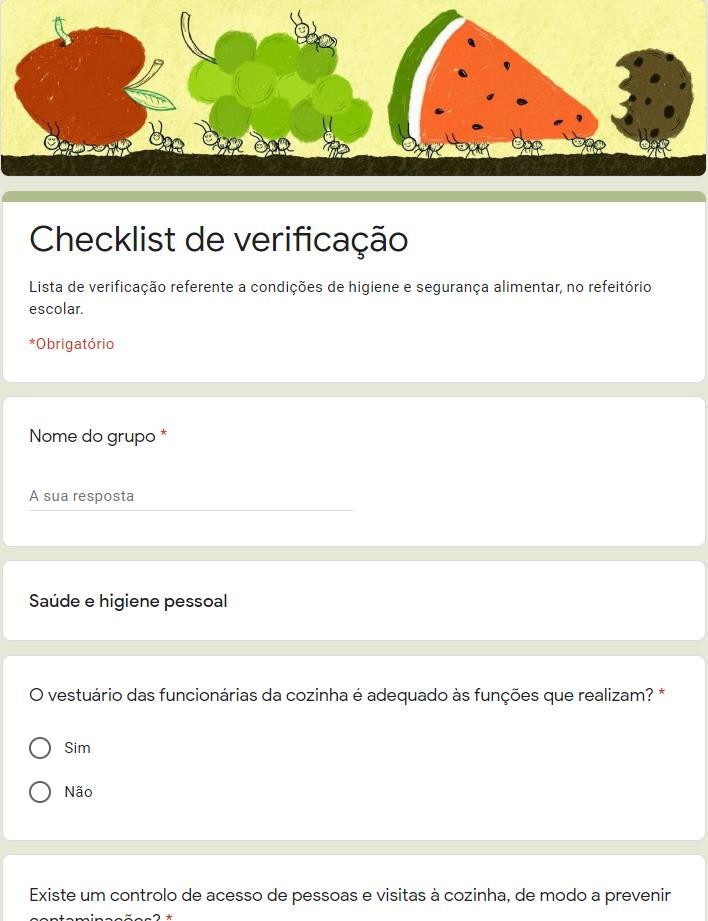
Groups C1 and C2
The groups tasked with identifying water-using activities in the cafeteria will enter the kitchen and circulate carefully, guided by the teacher and the present staff, as well as throughout the rest of the cafeteria. They'll collect photographs of locations where water is consumed or used with the help of a tablet and the Google Keep tool, recording a brief description associated with each photo, for example, "washing vegetables."
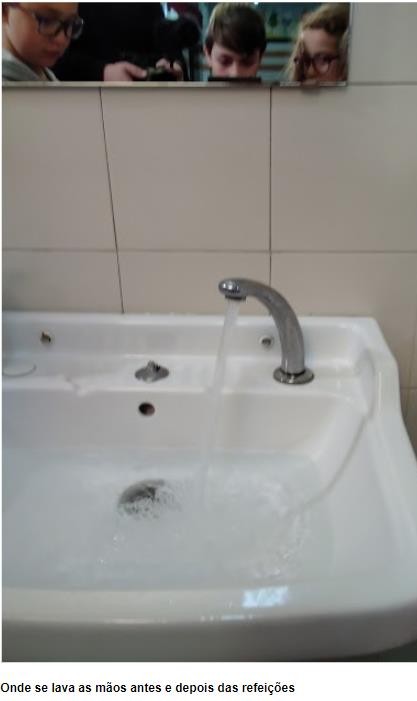
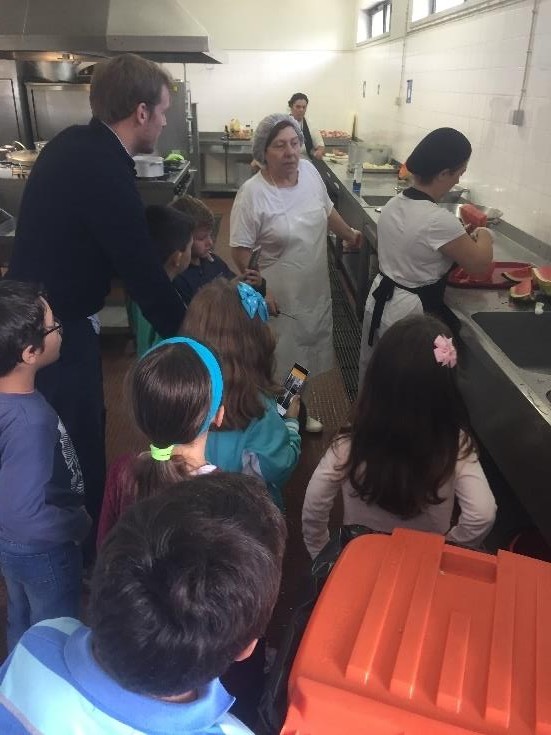
Conclusion of the Activity
All groups are asked to present the data collected during the cafeteria visit to the rest of the class, using projection. This data will be discussed, and where necessary, compared with the data discussed at the beginning of the activity.
When groups C1 and C2 present their work, it will be discussed from the perspective of planet sustainability. The entire class will be asked to suggest measures to reduce water consumption in the school cafeteria kitchen. These measures will then be structured into a water consumption reduction plan.
Finally, a document will be prepared containing the records and observations made by all three groups:
-
Photograph of the healthy eating plate, a screenshot of the spreadsheet with measured quantities, and a brief comment on the appropriate per capita serving for the meal;
-
Completed hygiene and safety conditions form and suggestions for improvement;
-
Identification of locations and activities with water consumption and measures for reducing water consumption.
A pre-structured document can be projected by the teacher and then complemented by the larger group. This document can then be handed over to the school cafeteria staff and the school cluster management.
Essential learnings
Evidence / Student action
- Identificar situações e comportamentos de risco para a saúde e a segurança individual e coletiva, propondo medidas de prevenção e proteção adequadas.
- Recolher, organizar e representar dados qualitativos e quantitativos discretos utilizando diferentes representações e interpretar a informação representada.
- Registos no Google Keep, formulário e folha de cálculo;
- Documento com propostas de intervenção para enviar ao responsável pelo refeitório escolar e direção da escola.
Gomes, S., Ávila, H., Oliveira, B. & Franchini, B. (2016). Capitações de géneros alimentícios para refeições em meio escolar: fundamentos, consensos e reflexões. Porto: Associação Portuguesa dos Nutricionistas, Faculdade de Ciências da Nutrição e Alimentação da Universidade do Porto, Programa Nacional para a Promoção da Alimentação Saudável da Direção-Geral da Saúde.
Harvard University. (2011). Prato: Alimentação saudável. The Nutrition Source, Department of Nutrition, Harvard T. Chan School of Public Health. Consultado em https://www.hsph.harvard.edu/nutritionsource/healthy-eating-plate/translations/portuguese/ em 6 de janeiro de 2018.
Lima, R. M. (2018). Orientações sobre ementas e refeições escolares. Ministério da Educação - Direção-Geral da Educação, disponível em http://www.dge.mec.pt/sites/default/files/Esaude/oere.pdf
Introduction
In this activity, we'll visit the school cafeteria, organized into small groups, with the following objectives:
-
Understand essential safety and hygiene conditions in preparing meals at the school cafeteria.
-
Create a "Healthy Eating Plate" using the ingredients from the meal served in the cafeteria, measuring appropriate quantities according to the energy needs of 1st Cycle Primary School students.
-
Document photographically tasks that consume water during meal preparation in the cafeteria.
At the end of the activity, the working groups responsible for each topic will present and share their recorded data and discuss their observations with their classmates.
Groups A1 and A2 - Determining the Daily Menu's Per Capita Serving
Groups A1 and A2 will be responsible for determining the per capita serving of the daily menu in the cafeteria. They'll create a "Healthy Eating Plate" with the appropriate quantity of each ingredient, in line with the energy needs of 1st Cycle Primary School students.
The average energy needs for a 1st Cycle student (6 to 10 years old) for the lunch meal are 492 kcal to 574 kcal (out of a total of 1640 kcal daily).
|
|
Macronutrients | ||||||
|
Age group |
Energy value for the lunch meal |
Energyvalue kcal (quantity in grams) |
|||||
|
Carbohydrates |
Lipids |
Proteins |
|||||
|
|
|
55 % |
75 % |
15 % |
30 % |
10 % |
15 % |
|
3 – 6 years |
420 kcal |
231 kcal (58 g) |
315 kcal (79 g) |
63 kcal (7 g) |
126 kcal (14 g) |
42 kcal (11 g) |
63 kcal (16 g) |
|
6 – 10 years (1.º CEB) |
492 kcal |
271 kcal (68 g) |
369 kcal (92 g) |
74 kcal (8 g) |
148 kcal (16 g) |
49 kcal (12 g) |
74 kcal (18 g) |
Average Energy and Nutritional Needs of a 1st Cycle Student
Your group will be in the dining area, equipped with a hybrid computer featuring a spreadsheet, a scale, the ingredients for the day's meal, and an empty plate.

Fill in the "Measured Ingredient Quantity" column (Column D) in the spreadsheet, recording the values measured with a digital scale for each ingredient (taring the container), to meet the appropriate quantities for 1st Cycle Primary School students.

Finally, they create a "Healthy Eating Plate" using the measured ingredients. This work will be important for the staff who prepare the meals, informing them of the appropriate quantities for a healthy diet for the 1st Cycle Primary School students who use the cafeteria.
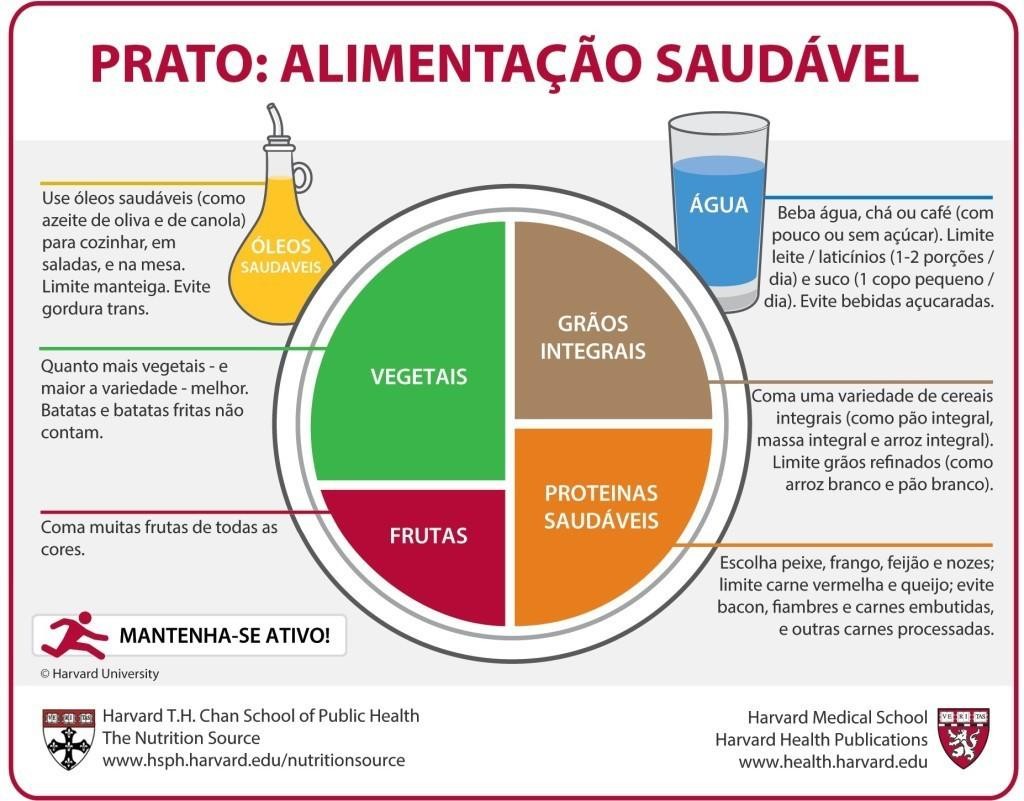
Group Tasks for the Cafeteria Visit
Groups A1 and A2: Determine Daily Menu Portioning
You'll also photograph this plate to compare it with the "Healthy Eating Plate" reference back in the classroom!
Groups B1 and B2: Verify Hygiene and Safety Conditions
You are responsible for checking the hygiene and safety conditions in the school cafeteria's food preparation area.
To do this, fill out the digital checklist form on your tablets, recording your observations as you move carefully under the guidance of your teacher and the staff. This work will be valuable for the meal preparation staff, offering them suggestions for improvement if any are identified. Finally, ask your teacher to display the results from both groups' responses in a graph for comparison.
Groups C1 and C2: Identify Water-Using Tasks in the Cafeteria Kitchen
You are responsible for identifying tasks that use water in the cafeteria kitchen.
Use Google Keep on your tablet to record photographs and short descriptions (e.g., "washing vegetables") of locations and activities that consume water. Move carefully under the guidance of your teacher and the staff. This work could be important for the meal preparation staff, informing them of suggestions for reducing water consumption, if any exist.
All Groups: Final Document Preparation
Prepare a document with your group's records and observations, which will become part of a joint document to be sent to the school cafeteria staff and the school cluster management. In this document, you should present:
-
A photograph of the Healthy Eating Plate, a screenshot of the spreadsheet with the measured quantities, and a brief comment on the appropriate portioning for the meal.
-
The completed hygiene and safety conditions form, an analysis of the responses in a graph, and suggestions for improvement.
-
An identification of locations and activities with water consumption and proposed measures for reducing water consumption.


